Projects for the conservation of unknown endangered species
Hereafter, you can learn more about the projects we support, including:
- Impression from selected projects in moving pictures
- A quick overview of selected projects
- Modus operandi of our project management
- Documents for applications and project reports
Get more information on how to support our projects under "Donate & Help".

Your contact person
Dr. Sven Hammer
sven.hammer(at)zgap.de
For telephone contact please get in touch with our office
Impression from selected projects in moving pictures
At every general assembly, various project partners participate in our clip award and send in wonderful videos. When presenting their work, they give us a great insight in their conservation efforts.
These video clips are a very good opportunity to get an impression of the benefits, that have been achieved with the funding provided. More videos are available on our Youtube channel.
Quick overview of selected projects
In the following, we provide a small selection of ongoing and completed projects that give you an impression of our work. Click on the pictures in the foto strip for a short summary.
-
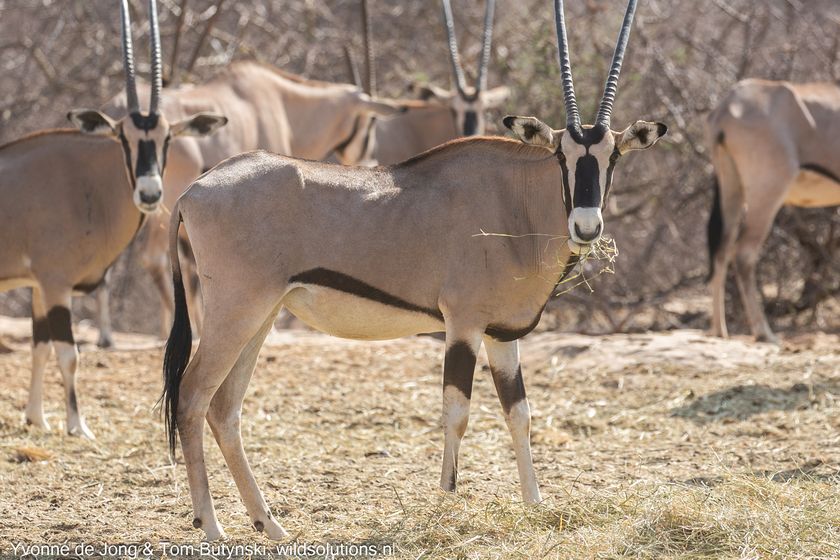
Antelopes of Kenya
Kenia bovids, Bovidae
Kenya, time-limited, since 2023
Projectcode: 7.Kenia bovids.KEN.2022-4768North-eastern Kenya is one of the largest, but at the same time globally least researched, biodiversity hotspots. To change this, we have been supporting a new project from the estate of Michael Amend since 2023, which focuses specifically on the antelope species of that region. So far, 15 different species such as greater and lesser kudu (Tragelaphus strepsiceros and T. imberbis respectively), the Eastern coastal bushbuck (T. fasciatus and before T. scriptus), East African oryx (Oryx beisa or O. gallarum), various species of the genus Madoqua and common duiker (Sylvicapra grimmia) have been recorded and documented. Many of these species have so far been classified by the IUCN as not endangered or only potentially endangered, but current data is mostly lacking. It is therefore important to gather new findings and to document potential threats.
One of the greatest threats to the species living in that region is the growing expansion of agriculture, which is fragmenting wildlife populations, reducing food resources and shrinking the antelopes' habitat, bringing them into direct conflict with livestock herds for water or food. Many of the widespread species originally native to Kenya have therefore become much rarer compared to earlier counts and historical data. Others, such as dik-dik species observed during the first project phase, have in some cases been detected for the first time so far north. However, more detailed analyses of the surveys carried out so far in 2023 are still pending. A further series of observations will be made in January 2024. The aim is to gradually move the surveys eastwards, for example to the little-explored Malka Mari National Park. Here, the project team hopes to make new discoveries of species not previously seen in Kenya, such as the Ethiopian grivet (Chlorocebus aethiops) and Soemmerring's gazelles (Nanger soemmerringi).
-

Atelopus
Colombia, time-limited, 2020
Atelopus are a genus of Latin American frogs with about 100 species, also known as harlequin frogs or toads. They occur between Costa Rica and Bolivia and are members of the family Bufonidae. This project studied the populations of three different endangered harlequin frogs, all of which occur at high elevations in the Colombian Andes.
A particular threat factor for these amphibians is the spread of the chytrid fungus, which affects amphibians and causes an infectious disease that usually is fatal. However, the populations localized in Colombia seem to be stable so far - special interest in this project is therefore also to determine how this stability has been maintained despite the risk of infection. The goal is to be able to derive possibilities for the conservation of other Atelopus populations. At the same time, measures to protect the harlequin frogs will be taken with the involvement of the local communities, while local schools will be educated about the importance of amphibians in the ecosystems.
-
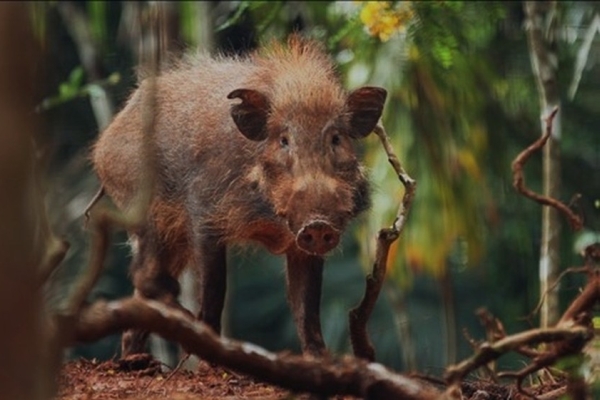
Bawean Warty Pig
Indonesia, time-unlimited, since 2013
As there was hardly any information available on this species, the project initially aimed to gather basic data about the threatened species. Particularly with regard to the strength of the population and its preferred habitat on Bawean. In addition, the local population was to be involved in the project and sensitized to the threat to the pigs, as they often destroy farmers' fields in search of food, which leads to recurring conflicts. Behavioural studies were carried out at the Cikananga Wildlife Center and compared with the behaviour of the animals in the wild in order to establish guidelines for reintroduction. In addition, lead by our PCBA team, a new breeding facility is set up on the island to start urgently needed breeding efforts.
-
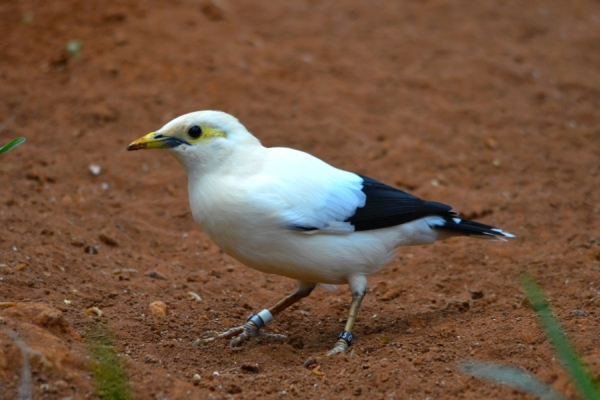
Black-winged Starling
Indonesia, time-unlimited, since 2014
Since 2014, ZGAP has been funding a reintroduction program for the critically endangered Black-winged Starling in Bogor on the Indonesian island of Java. The starlings are successfully bred on the protected area of „Taman Safari“ and are then released into the wild in a gentle reintroduction process.
-

Brown howler
Brazil, time-unlimited, since 2021
The brown howler monkey is one of the endemic species of the Atlantic Forest and is categorised as endangered both in Brazil and worldwide. The species is completely extinct on the island of Santa Catarina, as it was heavily cleared in the past and the howler monkeys were hunted there. The brown howler monkeys are to be reintroduced there as part of this project.
In 2024, a separate rehabilitation facility is therefore to be set up for the howler monkeys and cooperation with local residents will be intensified as part of citizen science projects to count and observe howler monkeys in the forests. In January of this year, a group of howler monkeys were also reintroduced to Santa Catarina with the help of a soft-release process in which the animals were able to decide for themselves whether they wanted to leave their enclosure. Further families are to follow in two different areas on Santa Catarina by the end of May. In addition, information and educational material is being produced for local residents, which can be used in schools, for example, to report on the monkeys and establish safe behaviour towards the animals for all sides or to recruit new volunteers to assist with the monitoring work.
This project we also support together with Wilhelma Stuttgart.
-
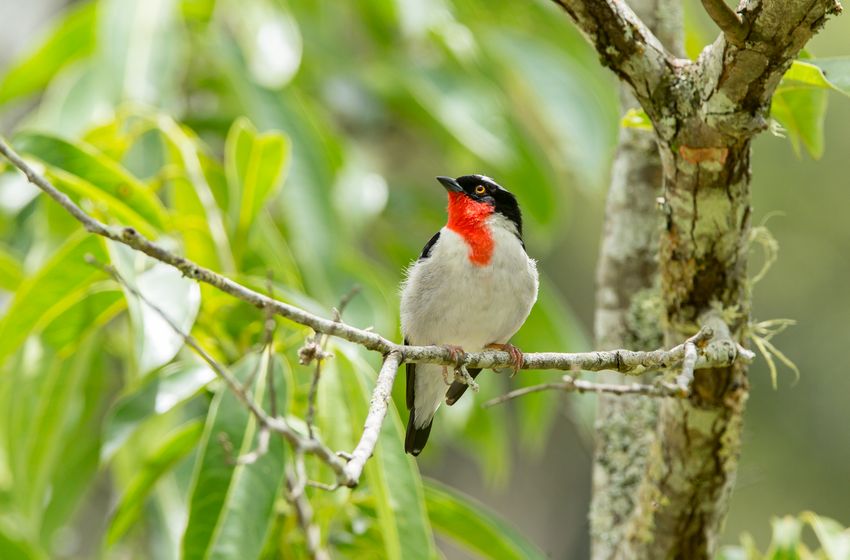
Cherry-throated tanager
Brazil, time-unlimited, since 2021.
At the start of the project, there were only 15 birds of the cherry-throated tanager left. This small bird is an endemic representative of the passerine family, only found in its small range in southwestern Brazil. The exact causes of the drastic population decline are not yet known, but immediate measures are urgently needed to save the last animals. The local project partner has therefore started to monitor the nests and protect them from potential predators, supported by us together with Cologne Zoo, Rostock Zoo, Hellabrunn Zoo, Basel Zoo, and initially Birdpark Marlow.
In addition to the establishment of a protected area, a slight increase in the number of birds has already been achieved in recent years. In addition, studies on the feeding and breeding biology of the tanagers have been initiated with a view to establishing a conservation breeding program.
-

Coendous and Santa Marta Mouse
Columbia, time-limited, 2022
Prehensile-tailed porcupines are a genus of rodents from the forests of Central and South America, closely related to porcupines. Starting in San Francisco de Sales and Manizales, the ZGAP-supported project in central Colombia investigates the occurrence and population levels of Coendou vestitus, C. rufescens, C. prehensilis, and Santamartamys rufodorsalis and identified specific threats to these species. The latter being critically endangered, while proper data to access the species’ level of endangerment is lacking for C. vestitus. Through the use of camera traps and field observations, and through active collaboration with the locals, it was observed that C. vestitus in particular not only stays in the trees but uses many different kinds of vegetation to hide. Farmers also reported occasional injuries of their dogs by the spines of the porcupines, which they use for defense. To provide additional hiding places, firewood piles have been set up by local farmers. As well, road signs have been installed to indicate the presence of these rodents to avoid their death in traffic accidents.
Surveys revealed that few animals could be detected in the region. For example, 81 camera trap images were sighted, but only 3 of these could be attributed to C. vestitus. This is an indication of the fragility of the populations and the need of protection. To further increase awareness of the prehensile porcupines, an identification book on South American porcupine species is to be published, containing also the scientific data compiled by the project.
Currently, this project is supported and funded together with Kleve Zoo.
-

Crested black macaques
Indonesia, time-unlimited, since 2019
Crested black macaques live mostly on Sulawesi Island in Indonesia, and have spread to some smaller islands in the vicinity. They have black fur with only a couple white hairs at shoulder height, which forms the name giving crest on their heads, here reaching a length of up to 15cm. This crest is particularly striking in male individuals, along with their long muzzle and high cheekbones. The macaques are diurnal and live in large groups, sometimes consisting of over 100 individuals, of which most are female. Young males leave those groups once they reach maturity, and occasionally form bachelor groups before joining different groups in which they procreate. The biggest part of their diet consists of fruits, though they will also eat invertebrates, bird eggs or smaller vertebrates like frogs or lizards if available.
The most important part of this project is collaboration with the local population. All permanent stuff are Indonesian, and most of them have been hired from the village near the local field station, which ensures a constant connection between the project and the local community. Additionally, the project is being worked on by both local and international scientists to ensure a regular exchange of knowledge.
A particular threat for the macaques lies in a regularly occurring human-animal-conflict, which results from the macaques’ behavior of consuming agricultural products. This behavior, which is considered stealing by the locals, leads to according responses regarding the animals. Through education, guarding of the plantations, and cooperation with the local farmers, these numbers are to be reduced.
For this project, we collaborate with Augsburg Zoo and Halle Zoo.
-
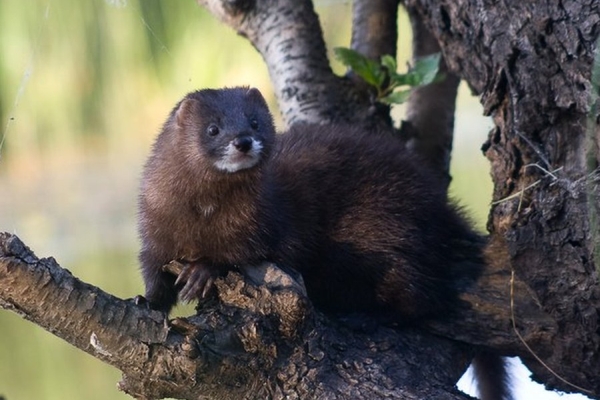
European Mink
Estonia/Germany, time-unlimited since 1995
ZGAP is supportung ex situ breeding programs and reintroduction projects in Estonia and Germany (Steinhuder Meer). Research particularly focuses on the detection of factors that influence the survial of released animals in the wild. Since 2014, the population on the Estonian island of Hiiumaa has experienced a very positive development, and in 2015 a sensation occurred at the Steinhuder Meer, when the first wild European Minks were born in Germany in almost 100 years.
-

Galapagos petrel
Ecuador, time-limited, 2020
The Galapagos petrel is, as the name suggests, a bird species native only to the Galapagos Islands. Males and females are almost indistinguishable to the eye, and the young ones also strongly resemble the adults in appearance. The birds spend much of their lives at sea, where they hunt for themselves and their offspring, but return to land for reproduction and breeding. Here, they are increasingly threatened through invasive species introduced by humans, such as rats, but also several domestic species like cats, dogs or cattle. Those species destroy their nests and often kill their chicks, so that the birds’ population has already decreased sharply.
This project, implemented by our project partner Jocotoco and supported by Malrow Bird Park, serves to conserve the petrels’ population, but also to control pests to protect the nests and stabilize their population numbers. Since 2019, seven colonies of birds and 193 breeding sites were identified at Jocotoco reserve. At the same time, wild cats and rats could be captured by the aid of traps. The installation of additional wildlife cameras will now be used to identify additional non-native species that might have previously evaded the traps, and to assess the threat posed by wild dogs and pigs, which can harm adult petrels or trample nests. Additionally, a widespread reforestation project has been started to restore the islands’ natural flora.
-
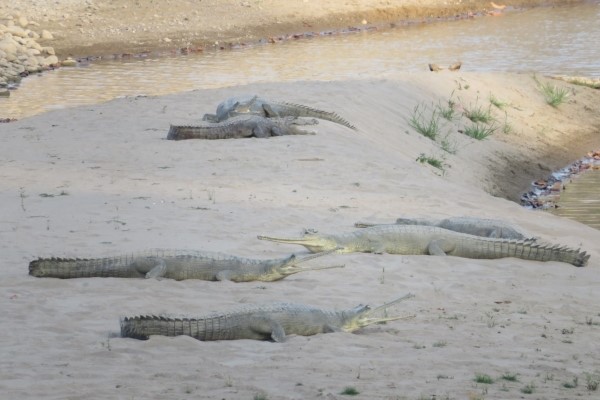
Gavial/ Gharial
Nepal, time-unlimited, since 2020
The gharial or gavial nowadays only exists in Nepal and northern India. Both populations are listed as Critically Endangered by IUCN. Characteristically for this species is the narrow, elongated snout, which ends in a hollow bulbous in males. This protuberance is used for vocalization – the males’ amplified hissing sounds can be heard up to one km away.
The project, which we are supporting together with Heidelberg Zoo, primarily aims to research the reproduction and nesting ecology of the gharial in Barida National Park in southwestern Nepal. Accordingly, two breeding groups of gharials consisting each of one male and several females could be identified in March 2022. In addition, several nests were found, one of which contained up to 60 juveniles. To protect the gharials’ breeding grounds, touristic activity is to be limited severely in the near future, to minimize disturbance from fishing or camping activities. Additionally, scientific experts were trained on site to collect further data regarding the animals’ breeding behaviour, environmental conditions, and the local gharial populations. In the following years, the scientific presence on site will be enhanced in order to continuously monitor the offspring bred during the current project, and to hopefully find additional breeding areas.
-

Giant Armadillo
Brasilia, time-unlimited, since 2019
The Parque Estadual Rio Doce in the state of Minas Gerais is home to the last population of giant armadillos (Priodontes maximus) to be found in Brazil's Atlantic rainforest. These seemingly primeval animals are listed by the IUCN as endangered (VU) and have been relatively little researched. However, it is clear that they have little to counter negative influences, primarily due to their low reproduction rate and low density of individuals. Our project partners from the Giant Amardillo Conservation Programme (GACP) are pursuing a holistic approach to protecting the species, which includes research into their distribution, causes of endangerment and protection of remaining habitats. The focus is now set on the human-wildlife conflict in the Mato Grosso region, especially with beekeepers. The giant armadillos discovered their bee hives a an easy food source and destroy the income of the beekeepers. As a result, many get killed or poisoned. To find a better coexistence, the project partners developed “armadillo-friendly honey” which is in the sale already. Over 134 beekeepers already signed the initiative and together with a comprehensive awareness campaign, the conservation efforts for the armadillos are on the right track.
This project is supported since 2019 together with Wilhelma - Zoologisch-Botanischer Garten – Stuttgart.
-
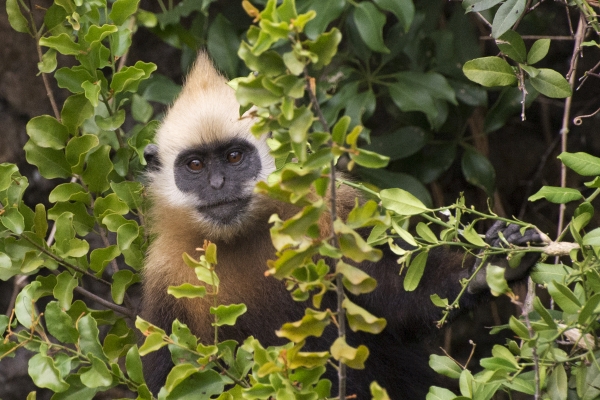
Golden-headed Langur
Vietnam, time-unlimited, since 2000
Since November 2000, the Golden-headed Langur has been protected by the "Cat Ba Langur Conservation Project" thanks to the dedication of ZGAP. The program has two goals: on the one hand, a sanctuary surrounded by a buffer zone was established in the area of the Natural World Heritage of Halong Bay National Park, where 35% of the remaining population live. On the other hand, measures were taken to protect langurs living outside the National Park: local people guard the sub-populations and their habitat and educate the public, local politicians, and tourists about the endangerment of the animals and their natural environment.
-

Golden skiffia
Mexico, time-limited, 2020
The Golden skiffia belongs to the Goodeidae, one of the most representative families of freshwater fish in Mexico, and is a fish species native only to the Rio Teuchitlán. Unfortunately, the Golden skiffia is already extinct in the wild, but will be bred and reintroduced into its habitat as part of this project. For this purpose, several hundred offspring of the skiffia are released into the river several times a year, while its water quality is closely monitored using various biochemical methods. Human pollution of the water is one of the main threats to the species. The goal is also to establish a long-term environmental education program on site to secure the assistance of the local communities in saving this species in its remaining habitat and in conserving natural resources in the river habitats of the region.
-

Green Avadavat
India, time-limited, since 2022
Green avadavats are endemic to India and have an extremely restricted range. The species is threatened due to illegal trapping and various anthropogenic threats. The project aims to study and protect the resident population in Mount Abu Wildlife Sanctuary. It is the first step in collecting primary data through surveys and the first attempt to start a conservation project that includes public awareness.
-
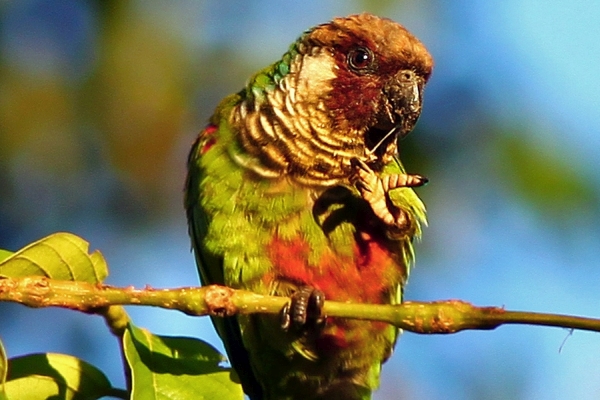
Grey-crested Parakeet
Brasil, time-unlimited, since 2007
As little was known about the bird's biology and ecology, ZGAP supported an extensive project in the Baturité mountains following a multi-pronged approach. So far, population size has increased threefold thanks to protective measures, poaching has decreased, and every year more nestlings fledge. Furthermore, new isolated populations were discovered in field studies.
-

Hunter's Antelope
Kenia/Somalia, time-limited, 1997 and 2011
Intensive fundamental research concerning the population's demography and choice of habitat was necessary to optimize future population management. These works were funded by ZGAP.
-

Javan Slow Lori
Indonesia, time-limited, 2012
The cute Javan Slow Loris are very popular companion animals. Due to ongoing and serious hunting for the illegal pet trade,their population has collapsed by at least 80% over the past 25 years. ZGAP funded field studies for the determination of the population size and - together with communicators - supported the establishment of a local protection program. In cooperation with "TRAFFIC Southeast Asia" short education films were produced and published on Youtube and television.
-

Javan Warty Pig
Indonesia, time unlimited, since 2007
In the Cikananga Conservation Breeding Center (Sukabumi, West Java, Indonesia), ZGAP established an ex situ population of the critically endangered Javan Warty Pig. The pigs bred in captivity function as a back-up population, while their offsprings are available for a reintroduction into the original habitat. Together with Taman Safari in Bogor, ZGAP established a second spatially divided population. Currently, we are working on a third breeding group at Taman Safari Prigen, East Java.
-
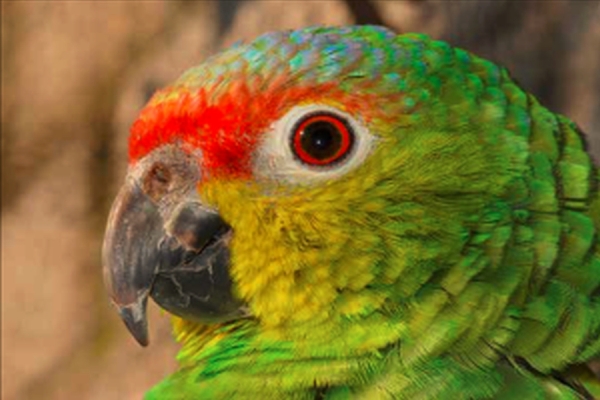
Lilacine Amazon
Ecuador, time-unlimited, since 1984
At the beginning there was a time-limited project to estimate the distribution and the population size of the Lilacine Amazon in northern Ecuador (Manabi and Esmeraldas). Special emphasis was put on the identification of important regions that were used for foraging, sleeping, and nesting. At the same time, the genetic varaiability of the northern population should be compared to the one in the southern part of the country. In 2016, it was decided to provide time-unlimited funding for this research program.
-

Long-tailed-chinchillas
Chile, time-unlimited, since 2007
Contrary to what was originally assumed, Long-tailed chinchillas (Chinchilla lanigera) are not extinct in the wild, but still occur in the wild in north-central Chile.
Wild long-tailed chinchillas are listed as endangered (EN) by the IUCN and the Chilean government, and trade in them is now regulated by Appendix 1 of the Convention on International Trade in Endangered Species of Wild Fauna and Flora (CITES). Nevertheless, the animals are threatened above all by the destruction of their habitat. Since 2007, the ZGAP is supporting a project run by the NGO "Save the wild Chinchillas", which implements research projects and conservation measures to protect these sociable animals.
-

Mountain Ungulates
Tajikistan, time-unlimited, since 2008
In the framework of two projects that were funded by ZGAP and further partners, community-based wildlife sanctuary were established, where traditional hunters quit illegal hunting, help to stop poaching through foreigners, and are in charge of wildlife monitoring and further management measures. On the basis of surveys, very conservative hunting quotas are defined, that are mainly used for hunting tourism. The money earned from these hunts and from ecotourism together contribute to the motivation of the rangers and provide financing of rural development measures.
-

Northern River Terrapin
Bangladesh, time-unlimited, since 2014
For many years, the conservancy organisation "Turtle Survival Alliance" (TSA) together with the Zoological Garden Schönbrunn (Vienna, Austria) has dedicated its work with great commitment to a breeding program for this fascinating turtle, that is supposed to be extinct in the wild (see Slider). ZGAP has supported the work of TSA for years. Concurrently to these ex situ measures, it is necessary to continue long-time efforts to localise free-ranging individuals.
-

North Sulawesi Babyrusa
Indonesia, time-unlimited, since 2011
As the deployment of rangers is a fundamental parameter for the conservation of the species, ZGAP finances the salary for a ranger to relieve poaching pressure. Besides the direct protection of the habitat and the animals living within it, our project partners are seeking to raise awareness for the species' vulnerability among local communities. For instance, this includes the organisation of excursions for students and pupils of schools in the area. Furthermore, scientific studies are carried out in the project region.
-

Pacarana
Colombia, time-unlimited, since 2004
The project for the establishment of a conservation breeding-programme and research on the pacarana has been funded already since 2004. Important new findings about the biology and reproduction of the shy rodents have already been collected and reintroduction measures have been started in 2017. However, further information on the ecology and habitat use of the species is needed to better understand the threat factors and thus protect the species from extinction.
-
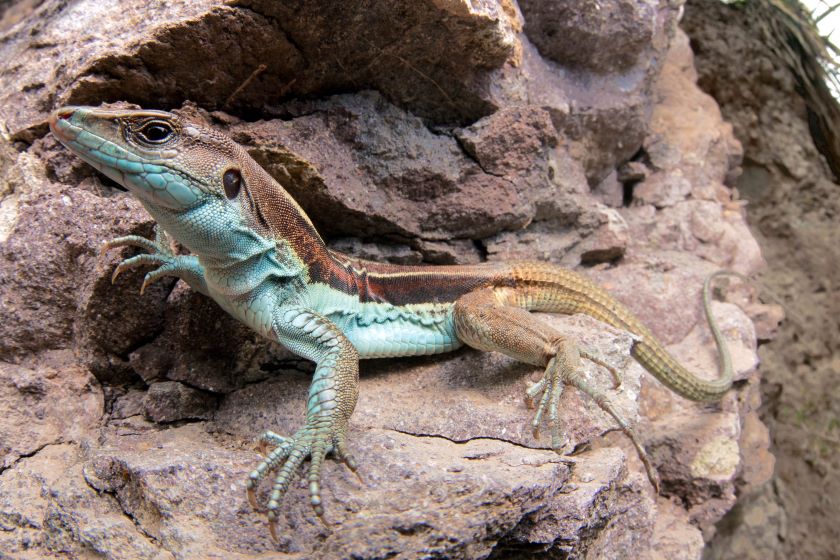
Peters-Ameive
Ecuador, time-limited, 2020
The Peters’ ameiva is a lizard endemic to Ecuador, belonging to the Teiidae family, also known as tegus. It prefers regions with scrubland at altitudes of about 1,500 meters asl and is classified by the IUCN as critically endangered. In fact, the species was considered to be extinct until two small populations were rediscovered a few years ago in the Azuay province.
As part of this project, populations of the Peters’ ameiva were detected in the Yunguilla Reserve, as well as in other regions near that reserve. With the help of surveys and life traps, several adult individuals were captured and brought to the Amaru Reptile Conservation Center in Cuenca. An ex situ breeding program is currently being established and, once several generations have been successfully bred, the offspring will be reintroduced to the reserve. At the same time, with the involvement of the local communities, the habitat destruction is to be counteracted, which is mainly driven by the expansion of the local infrastructure, but also by domestic cats or agriculture.
-
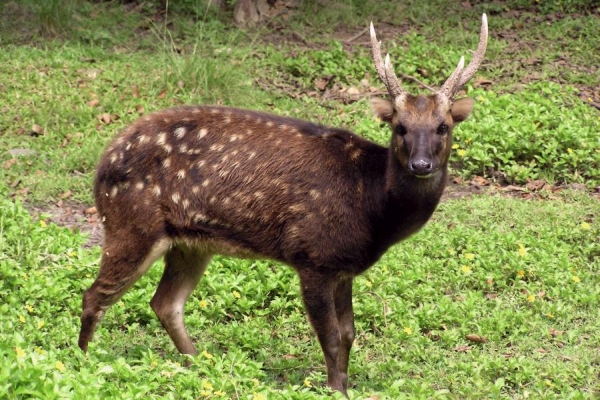
Philippine Spotted Deer
Philippines, time-unlimited, since 1984
When ZGAP took first interest in the Philippine Spotted Deer in 1984, it was (and still is) at the edge of extinction – but hardly anyone had ever herad about it. The species had simply been forgotten by the public. ZGAP made intensive inquieries, got in touch with experts, and was organisationally and financially involved in a rescue program, in which several zoos from Europe, Australia, and the United States participated as well. In close cooperation with the Philippine government, a breeding program was set up in 1990. The efforts were crowned with success: in 2015 the population cosisted of 110 individuals. As a consequence, the IUCN now classifies the species "only" as "endangered". However, the animals are under high pressure due to intense hunting, a ongoing habitat destruction. So the protective measures urgently need to be continued.
-
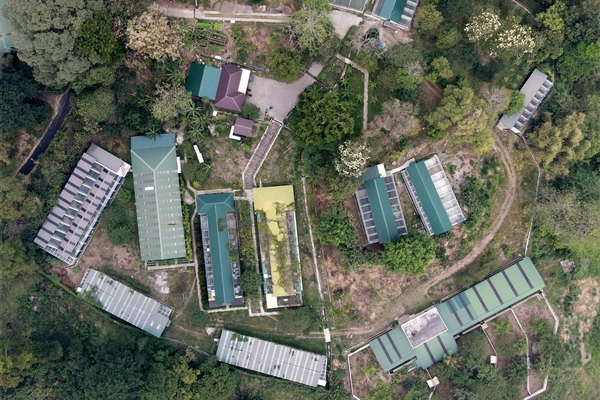
Prigen Arche
Indonesia, time-unlimited, since 2014
The Prigen Conservation Breeding Ark (PCBA) has been steadily expanding since 2017 in order to build up reserve populations for various highly threatened species which are in some cases already on the brink of extinction due to constant habitat loss and unregulated wildlife trade. The PCBA is a joint project of the Indonesian Taman Safari Group, ZGAP and Vogelpark Marlow further supported by a number of international zoos and other partners in various projects.
One focus is on the conservation breeding of endangered songbird species, for which over 210 aviaries (as of 2021) are currently available in several complexes. In addition, the PCBA includes aviary complexes for threatened parrot species and galliforms, with a focussing on Red-and-blue lory and White-faced bush quail.
In addition, there are complexes for endangered small mammals, especially for Javan Small-toothed palm civets, but also Javan warty pigs. In addition, the team of currently two curators and ten keepers also takes care of the conservation breeding of endangered labyrinth fish. Facilities for other focus species, including turtles and endangered invertebrates are under construction or in planning to respond to the increasing trade and loss of the respective habitats.
-

Pygmy Hog
India, time-unlimited, since 2006
The Pygmy Hog Conservation Programme (PHCP) was started in 1995. The focus of this initiative was on the conservation of the species and the protection and renaturation of its habitat. Since 1996, the partners in the programme have been breeding Pygmy Hogs in a very promising approach. By supporting the work of PHCP since 2006, ZGAP has contributed to the successful reintroduction of healthy Pygmy Hogs into the protection areas in Assam. The released animals have been monitored with the help of telemetry, and it could be observed that they have adapted well to living in the wild; encouragingly, they even have given birth to offsprings.
-

Red-vented Cockatoo
Philippines, time-unlimited, since 1998
In 1998, the Katala Foundation initiated a project on the Philippine island of Palwan to contribute to the conservation of the critically endangered psittacine species. Through intensive guard of nesting trees, feeding of nestlings, reforestation, reintroduction into the former habitat, education of rangers, and awareness programs for local people, the project team was able to achieve an increase in the population from 23 birds in 1998 to more than 350 in 2017.
-
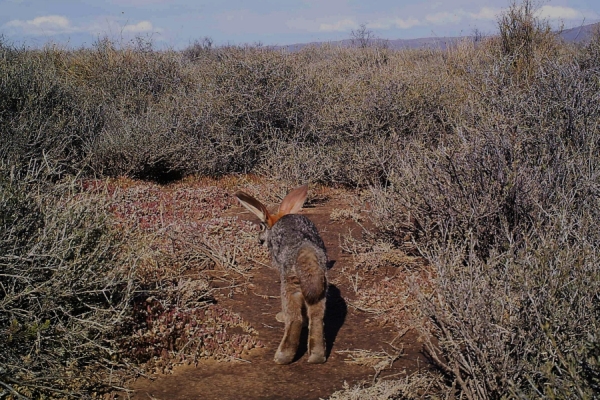
Riverine Rabbit
South Africa, time-unlimited, since 1998
ZGAP was the first conservancy organisation funding operations for the protection of the Riverine Rabbit. From 1998 to 2003, the project was exclusively supported through financial ressources provided by ZGAP, until the South African conservancy organisation "Endangered Wildlife Trust" attended to the rabbit's protection in 2003.
-

Rodentia
Columbia, time-unlimited, since 2010
In collaboration with ARASARI Conservation and Research, we have been supporting this project to protect various rodent species in South America since 2010.
We are focusing in particular on four different animal species: Couendou vestitus, Echinoprocta rufescens, Coendou sanctamartae and Santamartamys rufodorsalis. All four species face various threats in their respective habitats, and in the case of C. vestitus and S. rufodorsalis, there is actually not even enough data to assess the threat status of these species. Therefore, one of the main purposes of the project is to collect the relevant data while identifying and mitigating the most severe threats to the respective species. This is done primarily with the help of photo and camera traps, but also in co-operation with the local population. Observations by local farmers have shown that C. vestitus uses not only the trees in the region, but also any available vegetation as a hiding place. There have also been occasional reports of dogs being injured by the animals' spines as they are used for defense; to prevent this in the future, additional hiding places have been set up and road signs erected to prevent traffic accidents in the future. At the same time, local residents' knowledge of the species concerned has generally proven invaluable for the project’s work.
We are supported in this project by the Kleve Zoo.
-
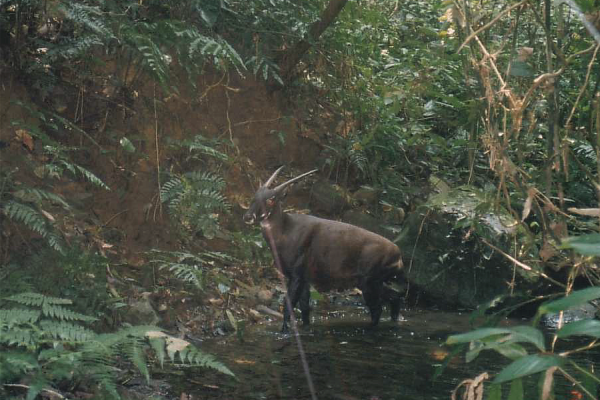
Saola
Vietnam/Laos, time-limited, 2013
The Saola is an extremely rare ungulate living in Laos and Vietnam, which was only discovered in 1993. ZGAP provided funding for a Saola Working Group meeting where the participants discussed methods for the location of the last reamining individuals, approaches to reduce poaching with snares, and the chances of an ex situ breeding program. In the course of this meeting, first urgent measures for the conservation of the Saola could be identified. However, the species remains highly endangered and requires strict protection.
-
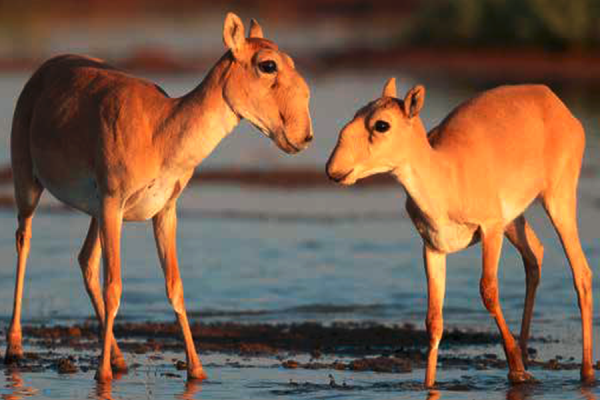
Saiga
Kazakhstan, time-limited, 2016-2017
Initially, two populations of Saiga in Kazakhstan were able to recover thanks to improved protective measures and a decreased economic attraction of commercial poaching. However, in 2014 a mass mortality occurred in the largest Saiga population: around 200,000 of the 230,000 animals died within a few days. The Saiga remains "critically endangered" a requires strict protection.
-
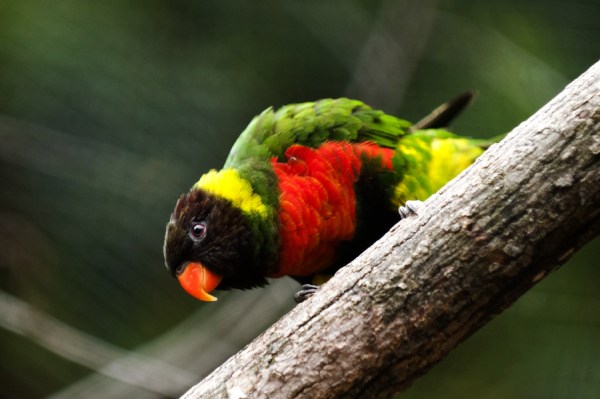
Scarlet-breasted Lorikeets
Indonesia, time-limited, 2014
The ZGAP Endangered Parrot Fund (FbP) and the Strunden Parrot Foundation (SPS) funded expeditions to Lombok and Bali to gain an overview of the status, distribution and habitat characteristics of Scarlet-breasted Lorikeets (Trichoglossus forsteni mitchelli) on these two islands. The project also aimed to focus the authorities' attention on the problem of illegal bird trade.
-

Striped Hyena
Tajikistan, time-limited, 2017
The Striped Hyena has become extinct in large parts of its former geographic range including Central Asia. After a video occurred in the internet showing several killed Striped Hyenas in Tajikistan in 2014, we supported a project aiming at the identification of potential distribution areas. With the help of camera traps the existance of the species could be confirmed. Next step is the establishment of a protection area.
-
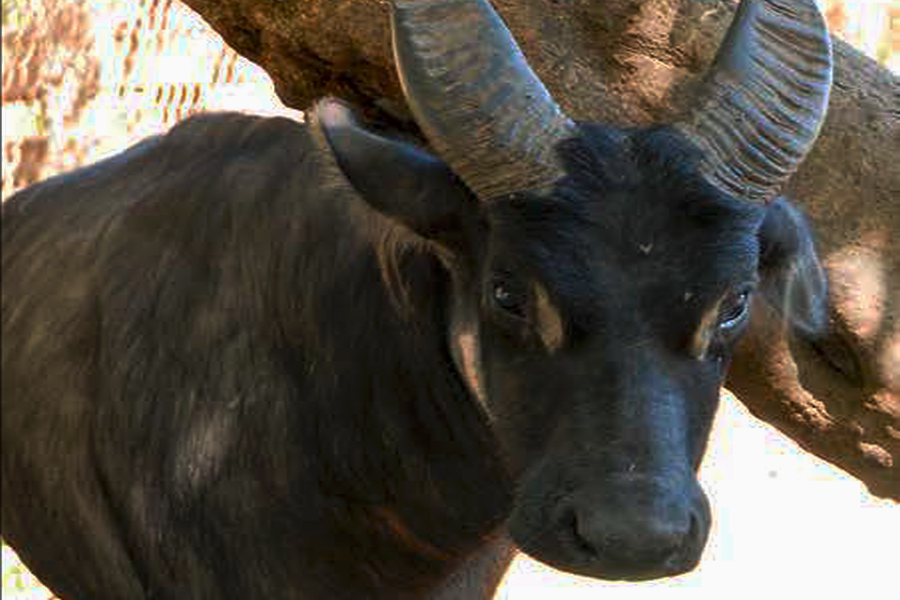
Tamaraw
Philippines, time-unlimited, since 2013
Almost nothing was known about the current situation of the Tamaraw population in the Philippines, when ZGAP decided to fund the conduction of a scientific excursion to answer a variety of different research questions. In the course of the study, the currently limited range of distribution and a threat from hunting and poaching could be identified. On this basis possible approaches for protective measures were developped that have to be turned into action now. In this context, the focus of the project was also on the indigenous people and their integration into the conservation efforts.
-

Togian Islands Babirusa
Indonesia, time-limited, 2023
The Togian babirusa is one of two babirusa species supported by ZGAP with corresponding projects. In contrast to the Sulawesi babirusa, it is characterized by a much hairier tail tassel. In addition, the large canine teeth that pierce the upper jaw - common to the species - are not curved, but instead relatively short and curve forward. They are the largest living babirusa species and classified as endangered by the IUCN. The large upper canine teeth, typical for the entire genus, which break through the jaw and in old animals can be so strongly curved that they grow back into the animal's jaw, are rather a status symbol and a secondary sexual characteristic and not suitable for feeding or similar activities.
The Togian babirusa is one of the most poorly researched mammal species in Indonesia. Therefore, our project is primarily intended to gather new data to document its distribution, and to develop further population surveying methods. For this purpose, 100 camera traps are set up and local people will also be involved to collect the relevant data. At the same time, the key characteristics of the habitat will be highlighted and local national park rangers are trained through workshops to help protect the species. Accordingly, there is a close cooperation with the Kepulauan Togean National Park Agency. In addition, citizen scientists are trained locally to assist with research and communication with local authorities and residents.
-

Turquoise Dwarf Gecko
Tanzania, time-unlimited, since 2009
The species occurs exclusively in Tanzania and its reproduction is dependent on a single tree species, the pandanus palm (Pandanus rabaiensis). Its mainly found in the Kimboza forest, the most species-rich lowland rainforest in Tanzania. The gecko lives on the mature palms in forest remnants that are highly threatened by fires, invasive tree species and deforestation.
In the current project phase 20 km of firebreaks against forest fires are being created and kept clear. The local population is being trained and deployed as anti-poaching patrols, tourist guides and forest wardens.
Saplings of the invasive West Indian cedar (Cedrela odorata) are cleared by hand throughout the area. This tree species grows very quickly after forest fires, while slow-growing tree species such as the pandanus palm and other native trees do not receive enough light. As a result, the cedar tree displaces the native flora. Since 2023, adult cedar alder trees have been killed by so-called circling, i.e. removing the bark all around the trunk. This means no more seeds are produced. A newly established tree nursery now provides 10,000 saplings of native tree species every year. They are planted for habitat renaturalisation. 10 villages are now involved in the restoration of the rainforest.
Materials, labour and training are financed by the project. The project thus creates a future for the geckos and the local population alike.
There are plans to extend the project to the neighbouring, heavily degraded Ruvu forest. The purchase of land in between, which will act as a green bridge, is also being planned.
For this species conservation project, we have been supported by Erfurt Zoo Park alongside other sponsors since 2020. In 2024, the project was part of the ‘Zoo Animal of the Year 2024: Gecko’. The money will be used for further expansion of habitat protection.
-

Vinaceous-breasted Amazons
Brasil, time-unlimited, since 2014
The Vinaceous-breasted Amazon (Amazona vinacea) is only found in south-east Brazil and some neighbouring areas in Argentina and Paraguay and is classified as endangered by the IUCN.
In collaboration with the Fund for Endangered Parrots (FbP) and our Strunden Parrot Foundation (SPS), the Instituto Fauna Brasil is working to reintroduce Vinaceous-breasted Amazons to the Araucárias National Park and to conserve their habitats and breeding grounds in the Brazilian state of Santa Catarina. For example, 12 of the endangered parrots were reintroduced in June 2023 alone. The birds' breeding behaviour is also observed on a daily basis so that, for example, successful rearing, but also failures due to disease, predators or similar, are noticed immediately. In cooperation with local residents, we are also working on ways to create jobs with as few ecological consequences as possible for the region's fragile biosystem and to raise awareness of the threats to the birds and protective measures for them, thereby contributing to socio-economic development as well as environmental and species protection in the region.
We have been receiving significant support for this species conservation project from the Wilhelma zoological and botanical gardens since 2019.
-

Visayan Warty Pig
Philippines, time-unlimited, since 2014
Through the funding of the Philippine Biodiversity Conservation Programme (PBCP) ZGAP has been supporting breeding programs for the Visayan Warty Pig and other endemic species of the Visayan Isles in Mari-it Conservation Park since the 1990s. Aim of the program is the long-term protection of the animals' habitat and the reintroduction of offsorings into the natural geographic reange. At the same time, research programs and educational measures for local communities are conducted.
-
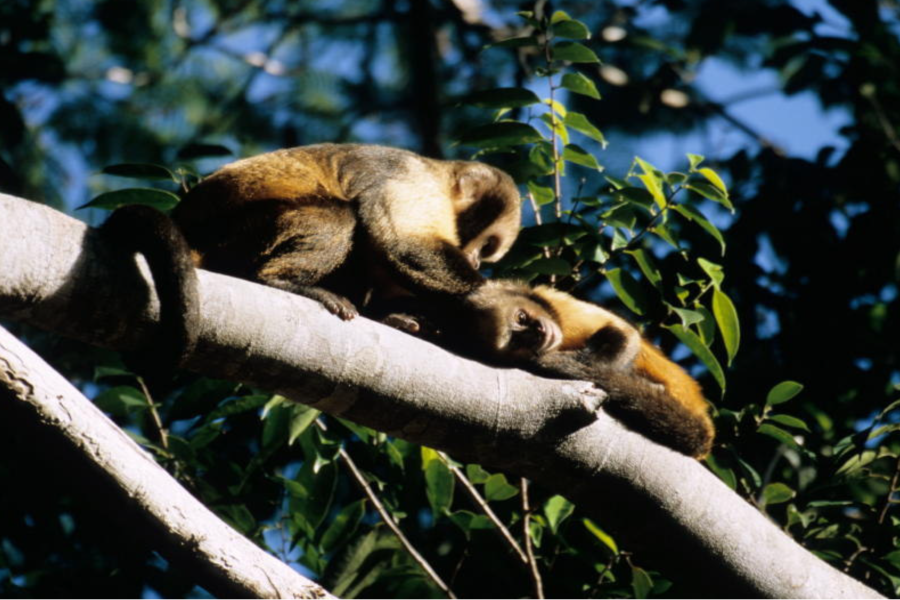
Yellow-breasted Capuchin
Brasil, time-unlimited, since 1994
Since 1994, ZGAP has been supporting research projects on the biology and the distribution of these critically endangered primates. Based on this data, our partners made suggestions for the establishment of protection areas in which the animals are protected from illegal hunting and further loss of habitat. Aditionally, they seek to gain individuals, that have been kept as pets, for the founding of an ex situ population.
-
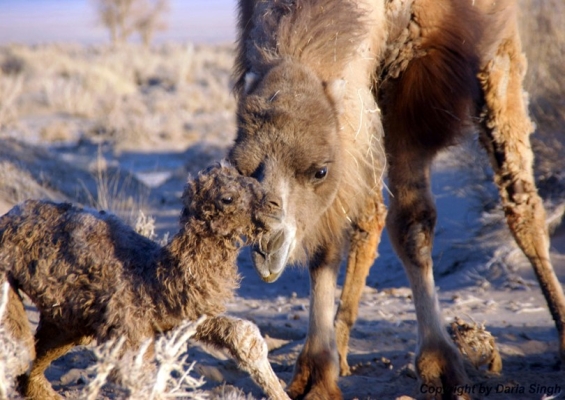
Wild camel
Mongolia, time-unlimited, since 2017
Of the once widespread wild camels (Camelus ferus), fewer than 1,000 individuals exist today. The animals can withstand droughts, cope with scarce food reserves and even resist nuclear radiation. However, heavy hunting and habitat loss have brought the species, which also competes with introduced livestock for scarce resources, to the brink of extinction. The ZGAP supports the Wild Camel Protection Foundation in conservation measures for the highly endangered calloused camels, which have been recognised as a separate species since 2008 - and are not the wild form of the Bactrian camel.
Choose one of the markers on the map for a geographical allocation of some of our projects.















































